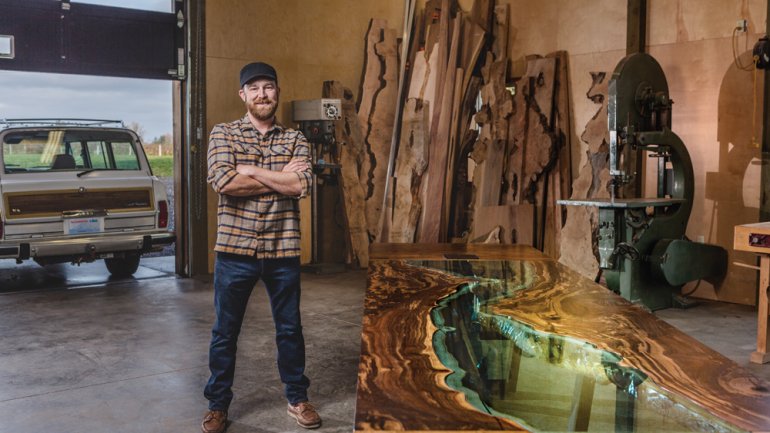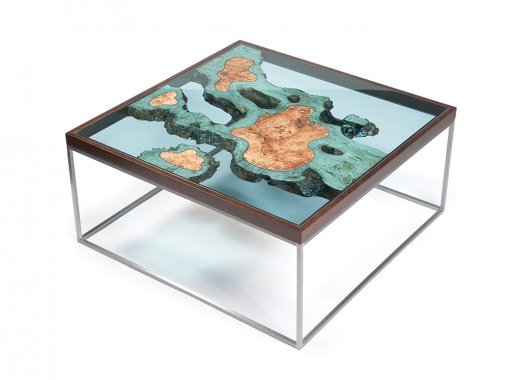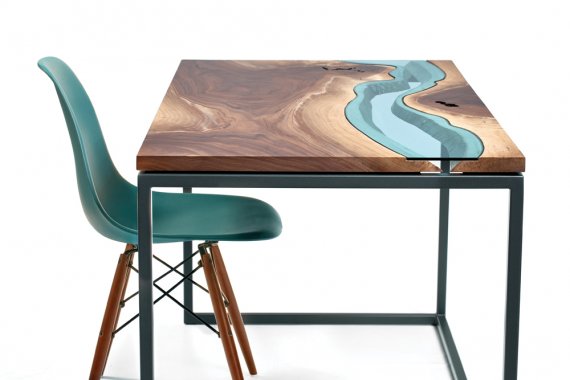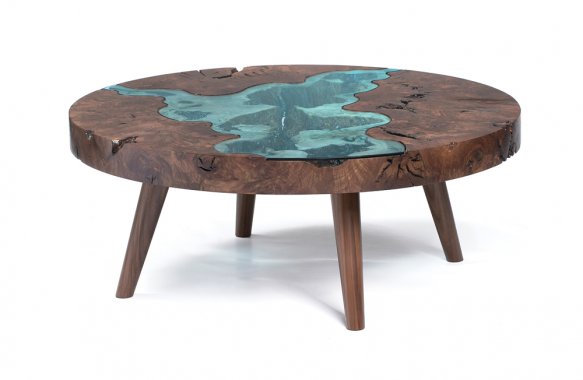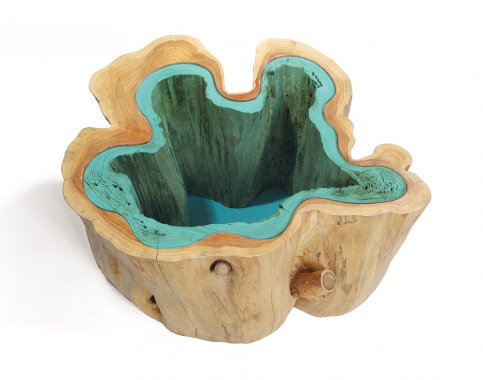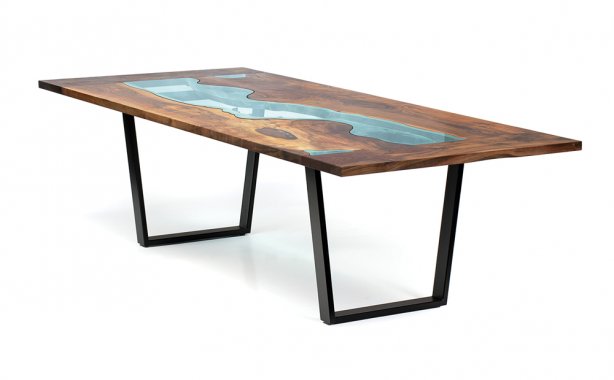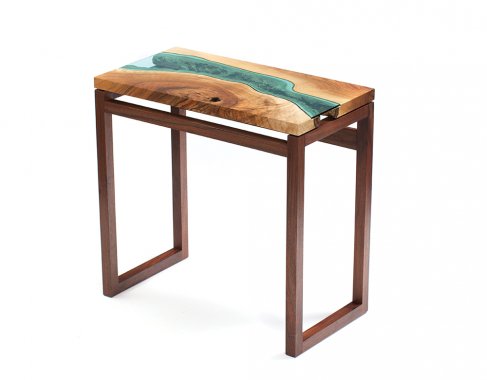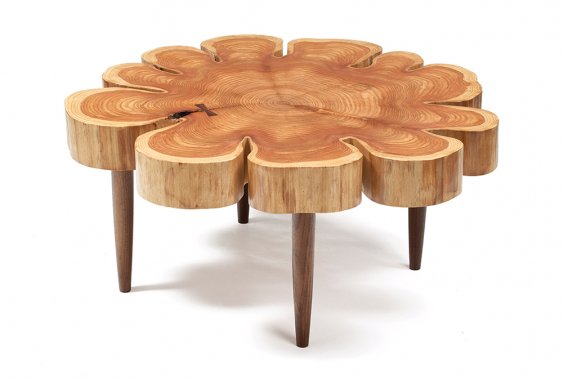Who Owns an Idea?
Who Owns an Idea?
An alert appeared on Greg Klassen’s website in January 2018. In the top right corner is a small box with “Important Message” in red letters. Click the link and you’ll find a letter announcing certificates of authenticity to all purchasers of his signature River ® Collection – wood slabs with live edges facing each other, forming a meandering channel filled with blue glass. “With the success of my original designs,” his note reads, “my work has become widely imitated.”
The certificates were the first step Klassen took to protect his work, which can sell for more than $15,000; at the time, he didn’t know that the second stage, trademark protection, would be approved. He certainly didn’t expect a heated reaction from a community accustomed to an open, collaborative spirit, igniting a discussion on how craftspeople should best protect their designs – or whether they even should.
There’s disagreement about whether the 37-year-old Klassen, who lives and works in northern Washington state, can legitimately claim credit for the River Table design. “So many people have said, ‘My dad made one of these 25 years ago,’ or ‘I saw an article in Sweden describing how they were making river tables 30 years ago,’ ” he says. “But literally no one has ever shown me a picture.”
Less disputed is that Klassen was the first person to popularize the form and to meaningfully brand it as the River Collection, once he began making the pieces in 2011. Before that, his furniture business, which he launched in 2008, had struggled; focusing exclusively on his river design after his work was featured on the Colossal blog and on Reddit in 2014 culminated in a wave of viral attention. Orders grew, as did Klassen’s profile among woodworkers, particularly on social media.
It was a mixed blessing. Not long after his breakout, he saw first a trickle, then a veritable flood, of river tables by other makers. He started second-guessing his Instagram posts, and after years of documenting his process on a blog, he deleted the entire archive. Klassen worried that the explosion of river tables would obscure his role in their creation and affect his business. In mid-2017, a woodworking magazine did a cover story on how to make river tables and didn’t mention Klassen, confirming his fears. “That made me feel sick for a week,” he says.
Late last year, a search for “river table” on Etsy yielded more than 1,200 furniture results, and thousands of posts on Instagram are tagged with some form of #rivertable. Some makers have used epoxy to fill the space between the live edges, while others use glass and a technique similar to Klassen’s.
The onrush of new river table makers hasn’t substantially affected Klassen’s business – he regularly turns away commissions and has been able to raise his prices – but that’s done little to put him at ease. “It’s probably my biggest business stress of the last couple years,” he says. “I’ve heard from respected makers who suggest everything from ‘Go scorched-earth and call out these losers on social media’ to ‘Start a dialogue that addresses the issue of plagiarism in the craft community.’ ”
He chose a different option.
Legal paths to protect his designs were limited. Patents are available for makers whose work takes a consistent form – as New York patent attorney George Gottlieb describes it, “If you’ve created a new, non-obvious shape, and a consumer would look at two of your products and say, ‘Those items are the same,’ then you’re probably going to get through.” What a patent doesn’t cover, however, is a design concept – so Klassen’s tables, which have interior shapes that vary based on the contours of the slab edges, wouldn’t qualify, despite a fundamental similarity.
So a patent was out. But Klassen recalled that, when his design went viral in 2014, a trademark lawyer had reached out. “You’d be wise to protect this idea,” she told him, “because I have a feeling you’re going to see a lot of imitators pop up.” He hadn’t seen the need for a trademark when she first suggested it, but now the idea made sense. If he couldn’t control the spread of river tables from a design standpoint, perhaps he could from a marketing one.
Since Klassen had branded his collection from the outset and could provide evidence that his work predated the boom, he had a compelling trademark case. In September, it was approved; he had the sole legal claim to the word “river” in the context of wood-based furniture or art.
Once the trademark had been issued, Klassen used Etsy’s reporting tools to file an infringement claim against the makers who had river tables listed in their shops. The company sided with Klassen – and then, as he describes it, “they came down with an absolute guillotine.” Instantly, any product listing with the name “river table” was removed.
Just as quickly, woodworking’s little corner of the internet erupted.
“[Etsy] doesn’t tell you that’s going to happen,” explains Klassen, who says he expected the service to simply notify the users about the claim. (Representatives from Etsy declined to comment.) “They also don’t tell you they’re going to send your personal information to all these people. That was a fun surprise. Tons of hate, so many emails, countless comments on Instagram. People found my number and texted me awful things. I got voicemails full of profanity.”
People whose Etsy listings were abruptly removed were understandably upset. Klassen’s Instagram post explaining his decision further fueled the uproar; some found it condescending. To those observers who already felt that Klassen was taking credit for a design he didn’t invent, the note was both galling and ironic.
Many in the online community felt a general sense of betrayal, as though Klassen had prioritized self-interest over the unspoken ethos of sharing evinced by those makers who document their processes on Instagram; “the free flow of ideas promotes the community as a whole,” says Denver woodworker Jason Miles, who makes work similar to Klassen’s. Klassen insists his efforts have never been about preventing people from making river tables: “I’ve never told anyone to stop making my design. People are conflating the two things – the design and the product name. This has just been about the name I gave to my work.” It’s a tricky message to communicate to an agitated set of critics in the best of environments, much less via Instagram.
But the response wasn’t all bad. Woodworkers who shared Klassen’s frustration with the influx of river-table makers left comments applauding his battle against similar work, and he says he received hundreds of supportive messages praising him for doing what’s best for his business and family. Even so, the fallout from Etsy enforcing his trademark weighed on him. “It wasn’t my intention to hurt other people’s businesses,” he says. “I simply wanted those people to know they were using a trademark that belonged to me.” Two days later, he rescinded the claim from Etsy, which restored the listings.
Klassen isn’t sure what he plans to do with the trademark now – or if he even needs to do anything else. “The story went viral on its own, so everyone knows I have this trademark,” he says. “I can enforce it anytime I choose. I’m going to leave that there for them to consider.”
Nor has his passion diminished for the design that has defined his career. He remains committed to the River Collection, working to take it in new directions, such as the Archipelago Table he developed last summer. The only thing that has changed is his willingness to invite his audience along as he works. “I didn’t show or hint at the pieces until I had fully created the series,” he says, “so people wouldn’t start imitating it before I was ready to show it off.
“People say imitation is flattery,” he adds, with weary certainty. “But whoever created that quote was not a designer.”
